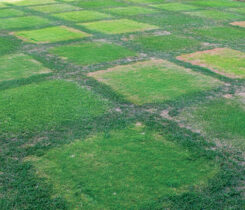Spring dead spot in bermudagrass
Lane Tredway, Ph.D., is a turfgrass pathologist with Syngenta. Lane has conducted many research projects on spring dead spot and has written extensively on the biology, management and control of spring dead spot. Lane is available at lane.tredway@syngenta.com for more information.
Q: Provide a brief overview of spring dead spot.
Spring dead spot (SDS) is a perplexing disease. After 50-plus years of research, we know SDS is a complicated disease and we have much to learn. SDS is caused by three separate fungi; Ophiosphaerella korrae, O. herpotricha and O. narmari, all of which respond differently.
The SDS pathogens are active in fall and infect the bermudagrass, but cold weather is needed to kill the turf. Infection by the pathogens alone will not kill turf. In general, SDS is favored by a cool, wet fall followed by a cold winter. The cold winter can be a prolonged period of cold or a sudden, severe cold snap.
There tends to be more SDS damage in wet, shaded areas, north-facing slopes and on sites that are desiccation prone.
Q: What cultural control practices are recommended to manage SDS?
Implement a program of year-round, best management practices for healthy, vigorous bermudagrass or zoysiagrass. SDS can be a problem on zoysiagrass as well. Promote winter hardiness of bermudagrass.
Just to give you an example of the challenge and frustration of managing SDS, we used to recommend acidifying the soil to help manage it, but recent research casts doubt on that approach. In a three-year trial in North Carolina, O. korrae effectively was controlled by calcium nitrate, which would tend to increase soil pH, but was not affected by ammonium sulfate. A different SDS pathogen, O. herpotricha, was exactly the opposite — it was suppressed by ammonium sulfate but not calcium nitrate.
While it is possible to identify which fungal species is causing SDS on a site, the process is expensive and time consuming, and I’m not sure if any disease diagnostic labs offer the identification service.
Q: What fungicidal control options are available?
Fungicides can work well to control SDS. Historically, superintendents have applied Rubigan (fenarimol) on putting greens in the fall to control annual bluegrass (Poa annua), and a side benefit was control of SDS. Rubigan is no longer offered for sale and existing supplies are limited.
Several fungicides are available to control SDS in fall, including Velista (penthiopyrad, Syngenta). Velista should be applied twice in fall, 28 days apart, with the first application made when soil temperatures consistently fall below 80 degrees F at a 1-inch to 2-inch depth, followed by a second application 28 days later, making sure soil temperature at a 1-inch to 2-inch depth has not fallen below 60 degrees F. It’s important that both applications are made before bermudagrass enters dormancy.
Spring applications of fungicides generally are not effective controlling SDS but may help the surviving turf to recover more quickly.
Q: Is there anything else you would like to add?
Before assuming the disease is SDS, be sure to get a diagnosis from a reputable lab. Extreme cultural practices used to manage ultradwarf bermudagrass greens have created additional stress on the grass, which has led to disease issues that are relatively new. Take-all root rot (Gaeumannomyces graminis var. graminis), rhizoctonia leaf and sheath spot (Rhizoctonia zeae) and cream leaf blight (Limonomyces roseipellis) all cause symptoms similar to SDS. It’s possible a fungicide will control SDS, but not one or more of the other pathogens mentioned above.










